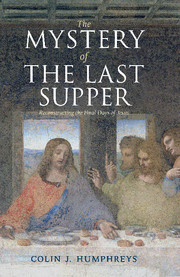Book contents
- Frontmatter
- Contents
- List of illustrations
- Foreword by I. Howard Marshall
- Acknowledgements
- 1 Four mysteries of the last week of Jesus
- 2 Dating the crucifixion – the first clues
- 3 The problem of the last supper
- 4 Can we reconstruct the Jewish calendar at the time of Christ?
- 5 The date of the crucifixion
- 6 The moon will be turned to blood
- 7 Did Jesus use the solar calendar of Qumran for his last supper Passover?
- 8 Does ancient Egypt hold a key to unlocking the problem of the last supper?
- 9 Discovering the lost calendar of ancient Israel
- 10 Was the lost ancient Jewish calendar used in Israel at the time of Jesus?
- 11 The date of the last supper: the hidden clues in the gospels
- 12 From the last supper to the crucifixion: a new analysis of the gospel accounts
- 13 A new reconstruction of the final days of Jesus
- Notes
- Bibliography
- Index of biblical and other ancient sources
- General index
12 - From the last supper to the crucifixion: a new analysis of the gospel accounts
Published online by Cambridge University Press: 03 May 2011
- Frontmatter
- Contents
- List of illustrations
- Foreword by I. Howard Marshall
- Acknowledgements
- 1 Four mysteries of the last week of Jesus
- 2 Dating the crucifixion – the first clues
- 3 The problem of the last supper
- 4 Can we reconstruct the Jewish calendar at the time of Christ?
- 5 The date of the crucifixion
- 6 The moon will be turned to blood
- 7 Did Jesus use the solar calendar of Qumran for his last supper Passover?
- 8 Does ancient Egypt hold a key to unlocking the problem of the last supper?
- 9 Discovering the lost calendar of ancient Israel
- 10 Was the lost ancient Jewish calendar used in Israel at the time of Jesus?
- 11 The date of the last supper: the hidden clues in the gospels
- 12 From the last supper to the crucifixion: a new analysis of the gospel accounts
- 13 A new reconstruction of the final days of Jesus
- Notes
- Bibliography
- Index of biblical and other ancient sources
- General index
Summary
They bound him [Jesus] and brought him first to Annas.
(John 18:12–13)At daybreak the council of the elders of the people, both the chief priests and teachers of the law, met together, and Jesus was led before them.
(Luke 22:66)Very early in the morning, the chief priest, with the elders, the teachers of the law and the whole Sanhedrin, reached a decision. They bound Jesus, led him away and turned him over to Pilate.
(Mark 15:1)In this chapter we will consider the sequence of events recorded in the gospels, from the last supper to the crucifixion, paying particular attention to their timing.
THE CONDENSED NATURE OF THE GOSPELS
Let us start by reminding ourselves that all biographies are compressed versions of history. In a biography a person's rich and varied life is condensed into a few hundred pages, with only the highlights usually recorded. The gospels are of necessity similarly selective, and as John writes at the very end of his gospel: ‘Jesus did many other things as well. If every one of them were written down, I suppose that even the whole world would not have room for the books that would be written’ (John 21:25).
Our study of the gospels in this book has shown that they each compress events differently: they are four separate narratives telling the story of the same person.
- Type
- Chapter
- Information
- The Mystery of the Last SupperReconstructing the Final Days of Jesus, pp. 169 - 190Publisher: Cambridge University PressPrint publication year: 2011

